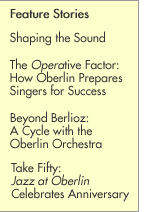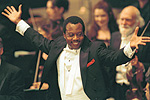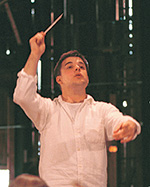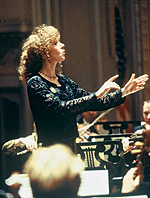
 |
|
Home :: Features :: Shaping the Sound :: Page 2 Shaping the Sound (continued) Switching Tempos Curiously, Harvey’s principal work with Baustian took place in his last year as a music education major, when he was soloist in Saint-Saëns’ Piano Concerto No. 5, with Baustian conducting the Oberlin Orchestra. Harvey continued in Oberlin’s master’s degree program, pursuing a concentration in choral conducting. To this day he laments that the music industry views choral and instrumental conducting as two distinct disciplines.
“It’s a political thing,” he says. “We compartmentalize people: if they conduct choruses, they can’t conduct symphonies; if they conduct ballet, they can’t conduct opera. That’s ridiculous. Not only are the skills needed in one area applicable to another, but also we should recall that real geniuses have written for all these media. Does it make sense that someone can conduct a Brahms symphony but not a Brahms choral piece?” That Harvey has bridged the gap is, in fact, a rare phenomenon in the conducting world, and it’s practically unheard of for an orchestral specialist to immerse himself deeply in choral study later. One of the joys of an Oberlin education, Harvey now realizes, is the breadth of experience that is available to a developing conductor, a breadth that is hard to duplicate later in life. “Of course it’s easy to get tied up with your friends and your classes and your own activities,” he says, “and for lack of time or awareness you don’t avail yourself of all the things that are going on. I wish I had sat in on more orchestra rehearsals, or that I had offered my services as a piano accompanist in a violin studio. With the College, the art museum, the theater, the many lectures, and so on, there’s such a wealth of stimulation at Oberlin.” But Harvey doesn’t dwell on his regrets. He is delighted with his career, which encompasses not only symphonic, choral, and operatic conducting, but also a busy schedule of master classes, lecturing, and audience development. On the International Podium
Of Oberlin conductors on the international scene, Michael Christie ’96 is chronologically closest to that “wealth of stimulation” described by Harvey. Chief conductor of the Queensland Orchestra in Brisbane, Australia, and the Colorado Music Festival in Boulder, Christie fell into his career almost by accident, supporting Zinman’s observation that a conducting career cannot necessarily be planned. A trumpet major, Christie had studied conducting at Oberlin with Spano and Peter Jaffe ’78. He was flirting with the idea of applying to the Oberlin master’s degree program, but life interrupted his plans. “I lucked out,” he says, “just as so many Oberlin students who do conducting luck out. For one thing, we have winter terms, when aspiring conductors can quietly ‘get their hands dirty’ conducting theater, orchestra, chorus, even opera projects. Plus I was conducting the choir at the Birmingham Methodist Church, and then the Northern Ohio Youth Orchestra hired me to coach their brass section. And when my trumpet professor, Byron Pearson, became ill, I assumed a lot of responsibility for the Oberlin Brass Guild.” Without really planning it, Christie was becoming a conductor. Thanks to a winter-term project that included leading Respighi’s Pines of Rome, he possessed a videotape of himself conducting a major piece of repertoire when, almost on a last-minute lark, he applied to the 1995 Sibelius Conducting Competition in Helsinki. To his amazement, he won a special award for “oustanding potential,” and in the space of a 16th-note, agents were handing him their business cards. Worried that he was in above his head, he sought advice from Spano, who became a willing mentor, as did such members of the Helsinki jury as Franz Welser-Möst and Esa-Pekka Salonen. What Christie needed to learn, he learned—for example, that “from the performance standpoint, rehearsal is more than 50 percent of what must happen.” “After a concert,” Christie explains, “if you talk to musicians in an A-list orchestra, like Cleveland or Atlanta, they’ll comment on the performance. But for orchestras on a level less than that, the musicians comment instead on the rehearsals. With them, it’s all about gaining trust so that in that moment of ‘going to battle’ in performance they won’t panic while doing what needs to be done.” Another Path to the Top
Jeannette Sorrell ’92 represents another individualistic approach to becoming a music director. She founded her own orchestra—Apollo’s Fire, the Cleveland Baroque Orchestra, one of a very small handful of historically informed orchestras flourishing in North America. Sorrell had already graduated as a piano major from Wake Forest University in North Carolina and spent time in the conducting program at the Cincinnati College-Conservatory before she arrived at Oberlin’s Baroque Performance Institute in 1986 to pursue her true calling as a harpsichordist. She enrolled officially at Oberlin as an Artist Diploma student, and within a few years the core of Apollo’s Fire started to coalesce around her. “The orchestra was ‘very Oberlin’ from the outset, and it still is,” she says. “We play regularly at Oberlin—the last time we were there I counted that two-thirds of the players onstage were either Oberlin alumni or faculty members.” Performing 20-odd concerts a year with perhaps 15 players for baroque programs and 28 for classical repertoire, Apollo’s Fire targets a niche different from that of the Cleveland Orchestra. Yet Sorrell points to Cleveland’s dedication to its symphony orchestra as critical to the establishment of her own ensemble. “In Cleveland, we have a culture of people really appreciating and supporting music on the highest level, so the community was ready to embrace a group like this in a way that many larger cities might not have been.” Her success echoes a point made by Spano, with whom she studied while at Oberlin: “You find things that work for you and you pursue them. I’ve tried conducting a lot of things, but I’ve now graduated to what feels like a good fit,” Spano says. Eternal Conducting Truths “The conducting program at Oberlin is directed more toward developing musicianship and allowing conductors to grow out of that development, rather than imprinting on students the idea of ‘being a conductor’ early on,” says Smith. “Even our master’s program is very small; there’s usually only a single student in that program at any time. But if students really show talent in that direction, we can help them in specific ways.” What would reveal that an aspiring conductor’s hopes are realistic? “A well-grounded sense of rhythm is key,” he responds. “It’s possible to work on that, but the sense of feeling music in a flowing, rhythmic way should be solid. Also, an innate physicality of motion needs to be in place. Again, we can build on that, but if someone is terribly awkward, nothing is going to change that. We certainly work on ear training, but it’s important for a student to develop a profound inner-ear conception of how things need to sound. And—very important—the ability to work with people in a positive way. Some people may still carry the old image of a conductor as a tyrant, but that’s not an applicable model anymore.” Smith continues with an anecdote: “A young man went to Richard Strauss for conducting lessons. Strauss shows him the pattern for conducting a bar in two, in three, in four, and then says, ‘Everything else you must learn on your own.’ “Of the conductors I’ve observed, the most successful have been able to delve into their personal sense and communicate their ideas both verbally and nonverbally. It comes from deep within. There’s not a single way to teach somebody how to conduct. There’s no formula, which was Richard Strauss’ point. In many ways the art of the conductor is a long-lasting process of self-discovery.” James M. Keller ’75, B.A. ’75, is program annotator for the New York Philharmonic and the San Francisco Symphony. He was recently named the Henry R. Luce Professor of the Emerging Arts at Oberlin College. |


